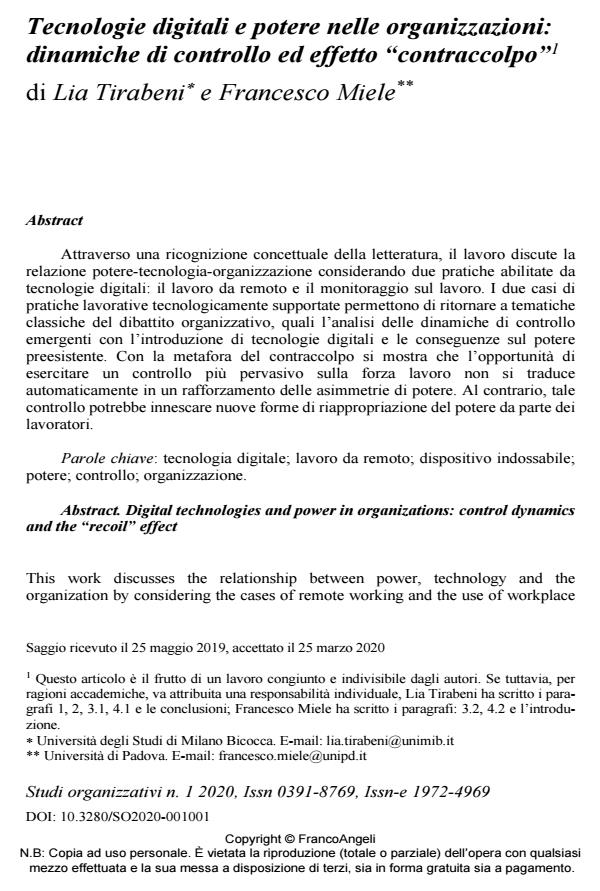Tecnologie digitali e potere nelle organizzazioni: dinamiche di controllo ed effetto "contraccolpo"
Titolo Rivista STUDI ORGANIZZATIVI
Autori/Curatori Lia Tirabeni, Francesco Miele
Anno di pubblicazione 2020 Fascicolo 2020/1
Lingua Italiano Numero pagine 29 P. 9-37 Dimensione file 369 KB
DOI 10.3280/SO2020-001001
Il DOI è il codice a barre della proprietà intellettuale: per saperne di più
clicca qui
Qui sotto puoi vedere in anteprima la prima pagina di questo articolo.
Se questo articolo ti interessa, lo puoi acquistare (e scaricare in formato pdf) seguendo le facili indicazioni per acquistare il download credit. Acquista Download Credits per scaricare questo Articolo in formato PDF

FrancoAngeli è membro della Publishers International Linking Association, Inc (PILA)associazione indipendente e non profit per facilitare (attraverso i servizi tecnologici implementati da CrossRef.org) l’accesso degli studiosi ai contenuti digitali nelle pubblicazioni professionali e scientifiche
Attraverso una ricognizione concettuale della letteratura, il lavoro discute la relazione potere-tecnologia-organizzazione considerando due pratiche abilitate da tecnologie digitali: il lavoro da remoto e il monitoraggio sul lavoro. I due casi di pratiche lavorative tecnologicamente supportate permettono di ritornare a tematiche classiche del dibattito organizzativo, quali l’analisi delle dinamiche di controllo emergenti con l’introduzione di tecnologie digitali e le conseguenze sul potere preesistente. Con la metafora del contraccolpo si mostra che l’opportunità di esercitare un controllo più pervasivo sulla forza lavoro non si traduce automaticamente in un rafforzamento delle asimmetrie di potere. Al contrario, tale controllo potrebbe innescare nuove forme di riappropriazione del potere da parte dei lavoratori.
Parole chiave:Tecnologia digitale; lavoro da remoto; dispositivo indossabile; potere; controllo; organizzazione.
- Connectivity and human capacity in digital transformation: the exploratory hypotheses of hyper industrial Emiliana Armano, Salvatore Cominu, Kristin Carls, Marco Briziarelli, in STUDI ORGANIZZATIVI 1/2021 pp.146
DOI: 10.3280/SO2021-001007 - Industrial democracy between neocapitalism and postfordism. The political and intellectual trajectory of Bruno Trentin (1926-2007) Francesco S. Massimo, in STUDI ORGANIZZATIVI 2/2024 pp.27
DOI: 10.3280/SO2023-002002 - The variable geometry of bargaining: implementing unions' strategies on remote work in Italy Anne-Iris Romens, Valeria Piro, Francesco E. Iannuzzi, in STUDI ORGANIZZATIVI 1/2022 pp.129
DOI: 10.3280/SO2022-001006 - Reintroducing technology to the coworking debate: prospects and problematics Maddalena Sorrentino, Lia Tirabeni, Maria Laura Toraldo, in STUDI ORGANIZZATIVI 2/2023 pp.70
DOI: 10.3280/SO2022-002003
Lia Tirabeni, Francesco Miele, Tecnologie digitali e potere nelle organizzazioni: dinamiche di controllo ed effetto "contraccolpo" in "STUDI ORGANIZZATIVI " 1/2020, pp 9-37, DOI: 10.3280/SO2020-001001